Gastric dilatation-volvulus, or GDV in dogs, is a deadly condition that should be known by every Golden Retriever owner. Also referred to by a colloquial but less informative name, “bloat,” GDV begins with a dog’s stomach becoming enlarged with food, fluid, or air, then twists around its own body. If treatment is not received very quickly, the twisting stops blood supply to the stomach and other organs, which can result in shock or death in a matter of minutes.
One of the earliest indicators of GDV in dogs to be noticed by a dog’s owner is a distended abdomen dog a hard, swollen abdomen of dog that could develop suddenly. In most instances, by the time abdominal distension becomes noticeable, things are already critical.
Golden Retrievers are one of those breeds most susceptible to GDV. The depth of their chest, coupled with genetic predispositions and normal feeding habits, keeps Golden Retriever bloating solidly within pet parents’ conscious thoughts. Knowing what to look for—and how fast things can progress—may be a life-and-death issue.
This blog will help you understand what GDV in dogs truly is, why Golden Retrievers are so prone to it, initial signs, including a swollen stomach, timeline of dog bloat, and exactly how to prevent this deadly disease. Save your dog from a fate that could be sooner rather than later.
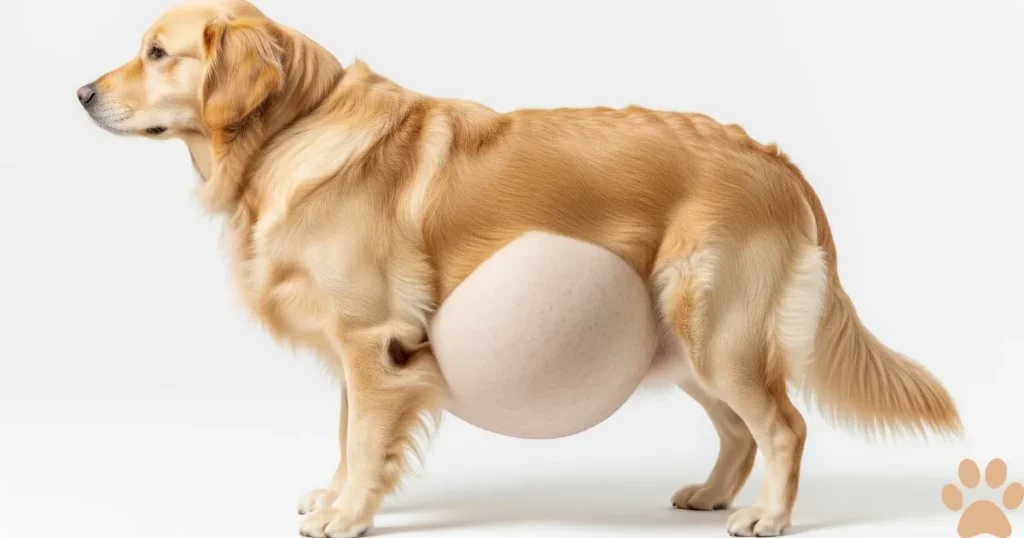
Contents
- 1 What Is GDV in Dogs? The Medical Emergency Explained
- 2 Why Golden Retrievers are Especially Prone to GDV
- 3 Identifying the Symptoms: Big Abdomen and Beyond
- 4 The Dog Bloat Timeline – How Rapidly GDV Becomes Life-Threatening
- 5 Causes of Bloat in Golden Retrievers
- 6 Preventing Gastric Diversion in Golden Retrievers – Is It Possible?
- 7 What to Do in an Emergency with Gastric Diversion? – Immediate Actions for Owners
- 8 General Checklist – Protecting Your Golden Retriever from GDV
- 9 Final Thoughts – Act Before GDV Develops
What Is GDV in Dogs? The Medical Emergency Explained
Understanding Gastric Dilatation-Volvulus
Gastric Dilatation-Volvulus, or GDV in dogs, is one of the deadliest veterinary medical emergencies. It occurs when a dog’s stomach dilates by filling with gas (dilatation), food, or fluid, and then twists or overturns (volvulus), cutting off blood flow to the stomach and other vital organs. It leads to shock, tissue necrosis, and, within a number of hours, becomes fatal unless immediately treated.
Although both terms are used interchangeably, there remains a distinction. Bloat in dogs refers to the initial stage, at which time fluid or gas distends the stomach. But once the stomach twists or becomes torqued, GDV takes hold, a life-threatening illness requiring immediate surgery.
A distended belly dog, or distended abdomen dog, which suddenly appears as a swollen, hard, drum-like stomach, is one of its cardinal signs. Other signs include pacing, restlessness, salivation or drooling, inability to vomit, and racing breath. If any of these signs are present in your Golden, it’s a red flag that requires immediate veterinary care.
Golden Retrievers, owing to their broad chest, are more prone to GDV than several other breeds. The understanding of GDV from regular bloat assists with immediate action. The dogs are capable of surviving, so long as they are treated promptly. Nevertheless, waiting even by one hour reduces their survival rates appreciably.

How GDV Develops and Why It’s Fatal Without Action
With GDV in dogs, things get critical fast—at times, within a few minutes. If a dog’s stomach twists or becomes distended with food, fluid, or gas, it may twist or rotate, typically 180° or more. This becomes a life-threatening problem.
Torsion cuts off both entry and exit paths (esophagus and intestines) and typically any expulsion of stomach contents or gases. The progressive buildup of gas, with rising pressure within the stomach, can disable blood flow to the stomach wall, spleen, and even heart, with consequential sudden tissue death, shock, and ultimate organ failure.
It’s one of the first apparent signs of this disease distended abdomen in dogs. The stomach of the dog becomes hard, swollen, and sensitive to the touch. Restlessness, pacing, salivation, pale gums, or collapsed posture are among its symptoms, and they are a sign of a life-threatening crisis.
GDV almost invariably kills unless immediate surgery is performed. Survival rates are very low with increasing time to treatment, so every dog owner, but particularly those who own breeds like Golden Retrievers, should be aware of what to look for and what to do.
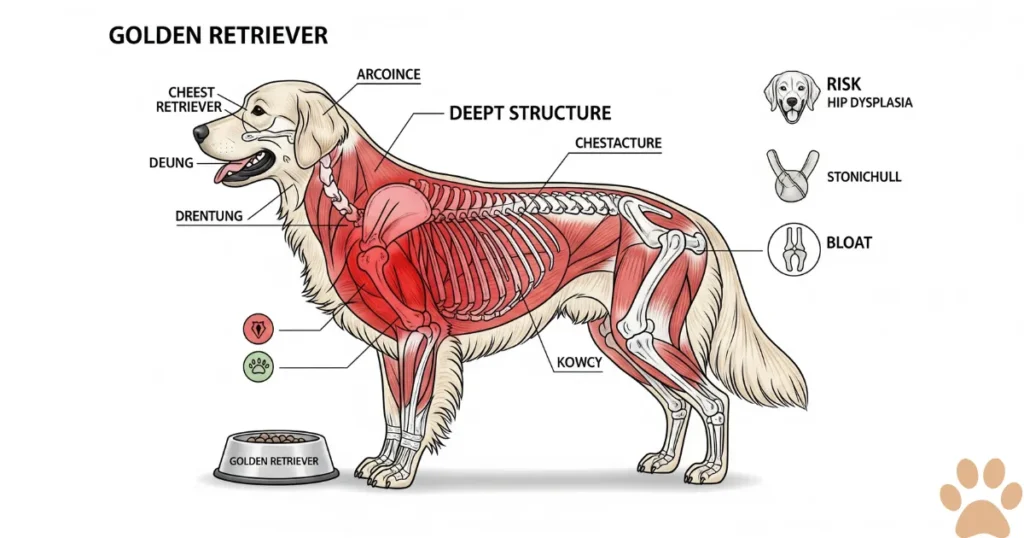
Why Golden Retrievers are Especially Prone to GDV
Golden Retrievers are one of the breeds most susceptible to GDV in dogs, and understanding why might assist in helping to act early to save your dog. Body structure, health history, and temperament are just a few things that influence a higher chance of Golden Retriever bloat.
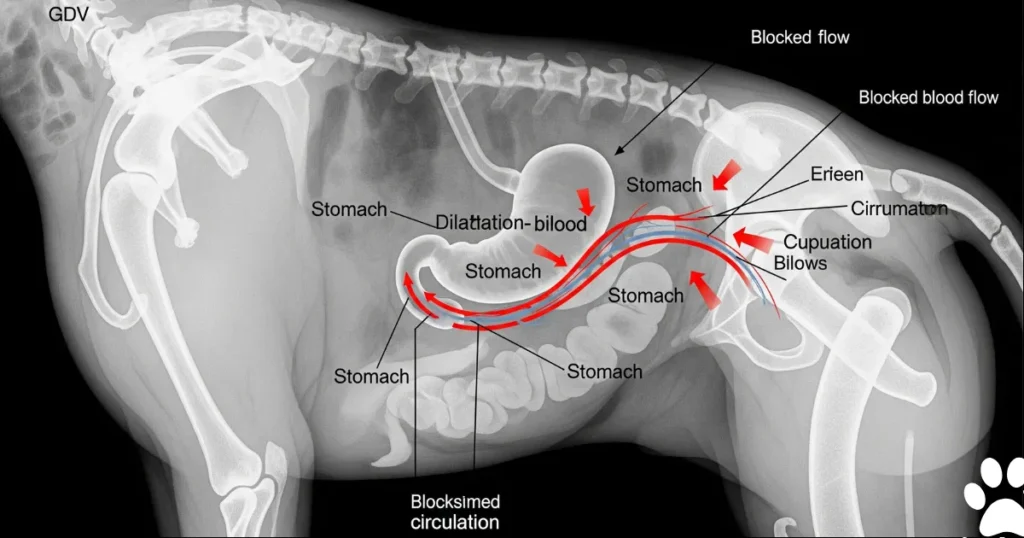
Golden Retriever Health Issues That Make Them Prone to Bloat
Golden Retrievers are prone to GDV, among other things, because they have a deep-chested body structure, allowing their stomach to have more room to twist and turn. Couple that with age factors—with advancing age, their likelihood to succumb to bloat increases—the result is a potential disaster with a dry, high-protein food diet.
Certain Golden Retrievers health problems, such as gastrointestinal sensitivities and slowed digestive rates, could also be involved. They can cause slowed stomach emptying, making it easier to accumulate pressure and gas.
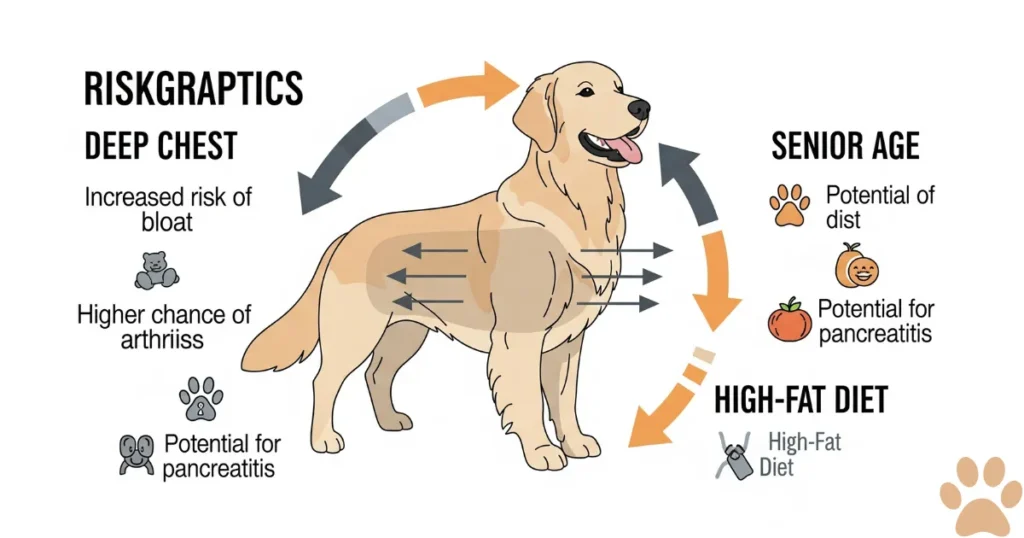
Inherited & Behavioral Factors
Genetics enters into it as well. If a Golden Retriever’s parent or littermates have experienced bloating or GDV, then a greater likelihood exists. These behavioral traits like speedy eating, competitive feeding among multi-canine households, or even pre-feeding anxiety can further elevate the risks. They lead to excessive intake of air and faster distension of the stomach, with occasional presentation as a distended belly in dogs even without full-blown symptoms.
Identifying the Symptoms: Big Abdomen and Beyond
Early signs of GDV in dogs are a life-and-death issue. One of the first and most noticeable signs is a distended abdomen dogs—a hard, bloated stomach that may come on suddenly. This, however, is just one of several warning signs that Golden Retriever owners should be aware of regarding bloat and GDV.
Most Common Symptoms of GDV and Abdominal Distension
GDV’s top alarm is a distended stomach—the stomach becomes prominently swollen and firm to the touch. This happens due to fluid and gas developing as a consequence of a twisted stomach and its contents becoming trapped. Aside from abdominal bloating, dogs generally present with symptoms of:
- Restlessness or pacing
- Drooling
- Unproductive retching or vomiting
- Rapid heart rate or shallow breathing
These are signs that are suggestive of an emergency, especially with large breeds, including Golden Retrievers. If your dog shows any of these symptoms combined, then act fast. GDV progresses swiftly and can be fatal within a span of a few hours.
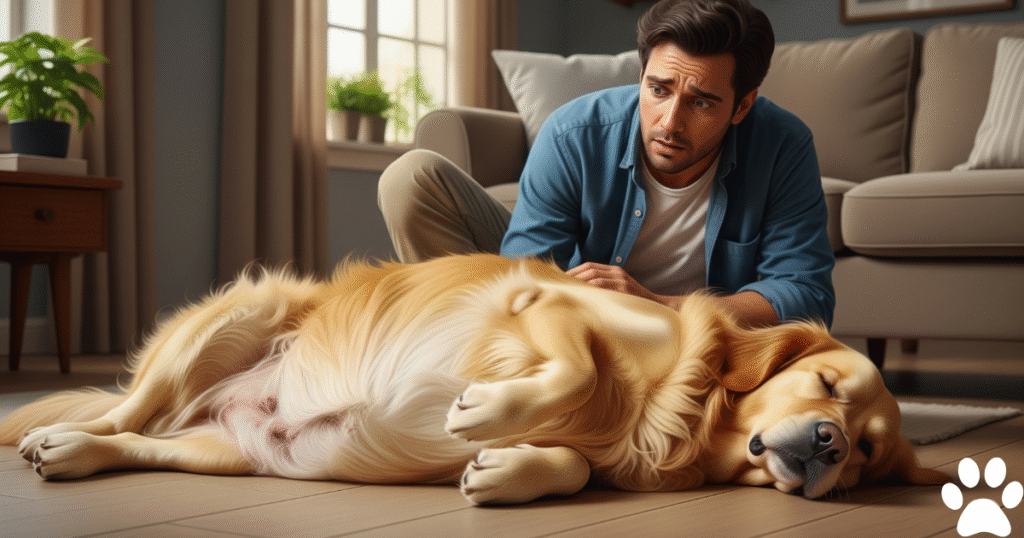
How to Tell If a Golden Retriever’s Belly Is Swollen
Not all bloating is an emergency, but how do you know the difference? The distended belly in dogs feels hard and drum-like—you may even hear a resonating note if you percuss it. This feels unlike a naturally distended stomach after a feeding, which feels mushy and may resolve within a bit. Be careful with pressure when feeling your dog’s stomach. If your Golden Retriever shows signs of pain or the belly seems very tight, don’t hesitate—call your vet immediately.
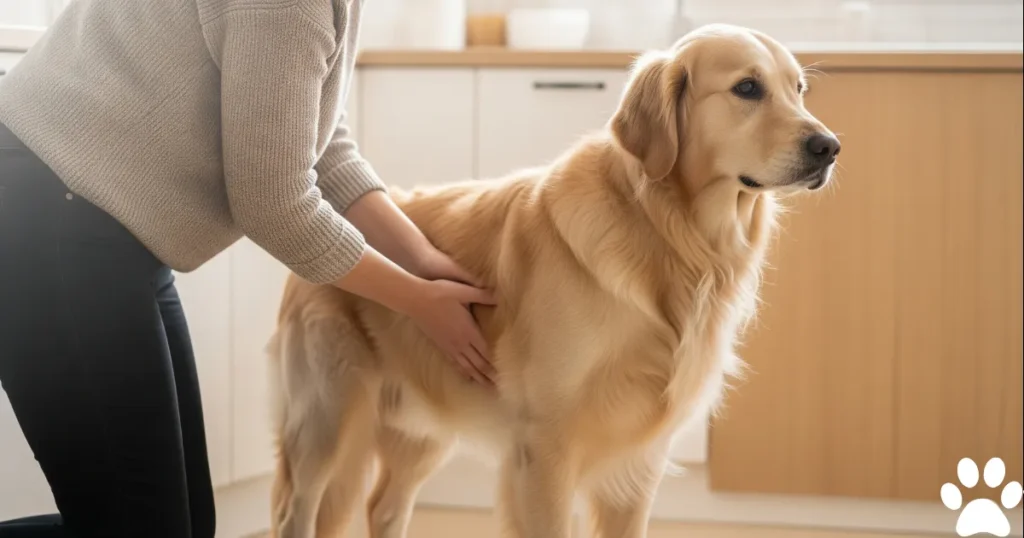
The Dog Bloat Timeline – How Rapidly GDV Becomes Life-Threatening
Time is of critical importance when it comes to GDV in dogs. Golden Retrievers are particularly vulnerable owing to their body structure and size. Knowing exactly how fast a condition advances remains crucial to a dog’s survival.
Critical Stages from Bloating to Collapse
Early minutes of GDV, the stomach becomes full with foam, fluid, or even gas, with a distended abdomen dog. If left untreated, the stomach twists off or experiences volvulus, sealing both entry and exit points of the stomach. Throughout the initial hour, appreciable changes are evident:
- Blood to the important organs is closed off.
- The dog can go into shock with diminished circulation.
- Labored breathing and collapse can shortly follow.
Death may occur within 1–2 hours from the commencement of symptoms, untreated. This outcome is explained within our Dog Bloat Timeline page.
Why Every Minute Counts – When to Seek Out the Vet
Do not delay if GDV is suspected. Even a 30-minute delay can significantly decrease survivability. Golden Retrievers with a distended belly that are retching, pacing, or becoming frantic should be seen immediately by an emergency facility.
Why GDV proves so fatal to dogs is that it becomes irreversible so fast. With tissue damage having already been caused, even surgery may be inadequate. That’s where getting to the vet within the first hour makes all the difference. Watch for these signs of emergencies:
- Pale gums
- Weak pulse
- Excessive drooling
- Unsuccessful attempts to vomit
Belly distension, then, is not a bloated stomach but a potential death sentence unless measures are taken right away.
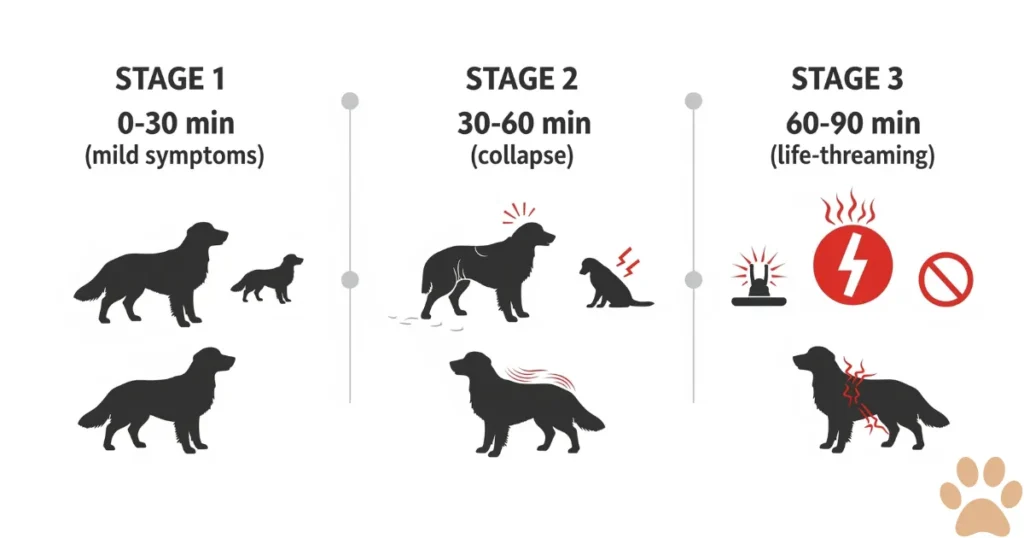
Causes of Bloat in Golden Retrievers
A distended abdomen in dogs, especially golden retrievers, can be a worrying symptom. While GDV in dogs is the most common cause of death, it is not the only reason your dog may suddenly bloat. Knowing all the possible causes will help you respond quickly and appropriately.
GDV Is Not the Only Culprit
While bloat in dogs caused by gastric dilatation-volvulus (GDV) is a serious issue, other factors can also cause a noticeable distended abdomen dogs:
Overeating: Eating large amounts of food too quickly can cause temporary bloating.
Water Bloat: Drinking water too quickly, especially after exercise or in hot weather, can cause the stomach lining to bulge and lead to GDV symptoms.
Gas: Some dogs naturally produce more gas in their stomachs, which can cause temporary bloat that goes away on its own. However, they should still be monitored.
If you notice signs of bloat, it is important to determine whether the cause is mild or life-threatening.
Common Triggers Specific to Golden Retrievers
Golden Retrievers are more prone to gas due to their breed characteristics. Their deep chests provide more room for bloat, which increases the risk of GDV. In addition to GDV, they may also have certain distended belly dogs, such as:
- High-fat diets or easily fermentable foods
- Excessive activity after eating
- Genetic predisposition to digestive problems or GDV
These risk factors are often discussed in connection with health problems in Golden Retrievers. Therefore, preventative measures are essential for the safety of your dog.
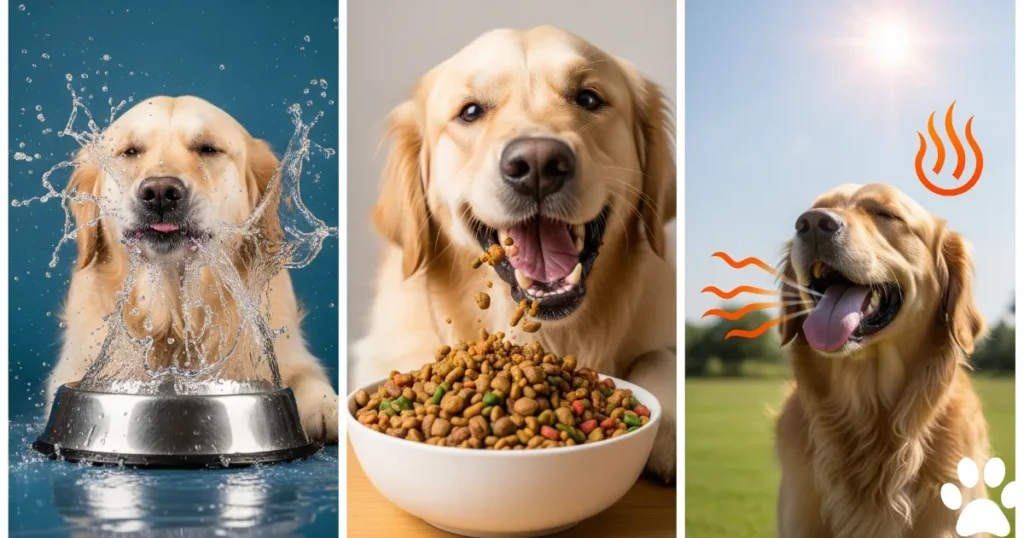
Preventing Gastric Diversion in Golden Retrievers – Is It Possible?
While GDV in dogs is a serious medical condition, Golden Retriever owners can use proven methods to significantly reduce the risk. Prevention includes a healthy diet, lifestyle changes, and, in some cases, preventive medical interventions.
Diet and Lifestyle Adjustments
One of the most effective ways to reduce the risk of gastric diversion is through proper nutrition and regular grooming. Golden Retrievers are especially susceptible to this condition due to their deep chests and active temperaments. Here’s how to reduce the risk:
- Offer your dog small meals more frequently, rather than one large meal per day.
- Use slow-feeding bowls to slow down the rate at which your dog eats.
- Avoid exercise 30 to 60 minutes before and after meals to prevent stomach movement and possible straining.
- Limit water intake immediately after meals or vigorous play.
- Only lift food bowls if recommended by your veterinarian (this is controversial).
These are all practical, evidence-based ways to incorporate how to prevent bloat in dogs into your daily routine. Controlling stressful environments, especially during feeding time, can reduce the risk of rapid eating or running, behaviors associated with bloat and GDV in dogs.
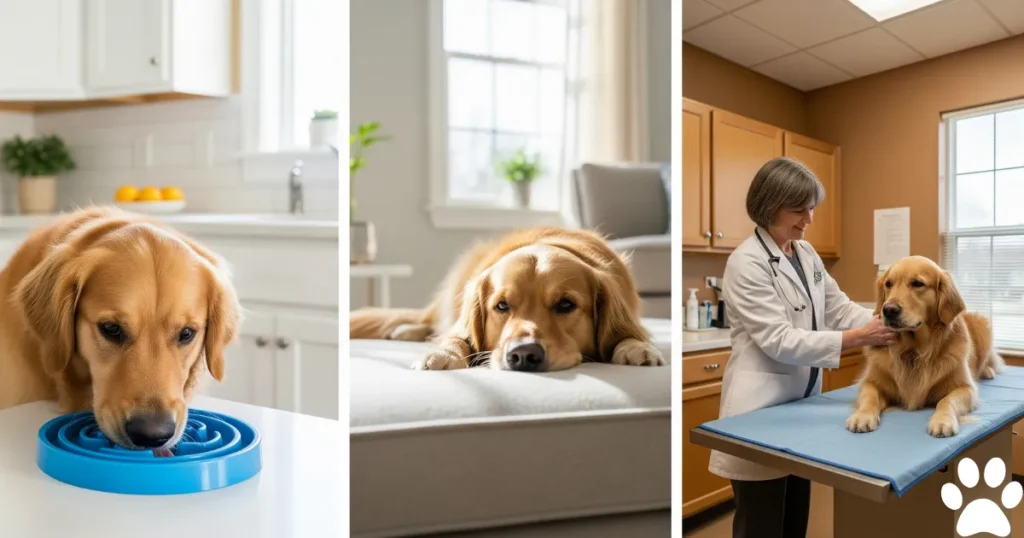
Should you Consider Gastropexy Surgery?
For high-risk breeds like golden retrievers, gastropexy is a preventative procedure recommended by many veterinarians. This procedure involves securing your dog’s stomach to the abdominal wall to prevent bloat. Here’s what you need to know:
Advantages: The risk of gastric torsion due to GDV is greatly reduced.
Disadvantages: General anesthesia and longer recovery time are required. Cost varies by location, but is typically between $400 and $1,000.
Best for: Dogs with a family history of GDV, anxious eating behavior, or dogs that have had other surgeries such as neutering.
Not all dogs require a gastropexy, but it may be worth serious consideration if your veterinarian believes your Golden Retriever is at risk. This procedure is a preventative option to help keep your Golden Retriever healthy and live longer.
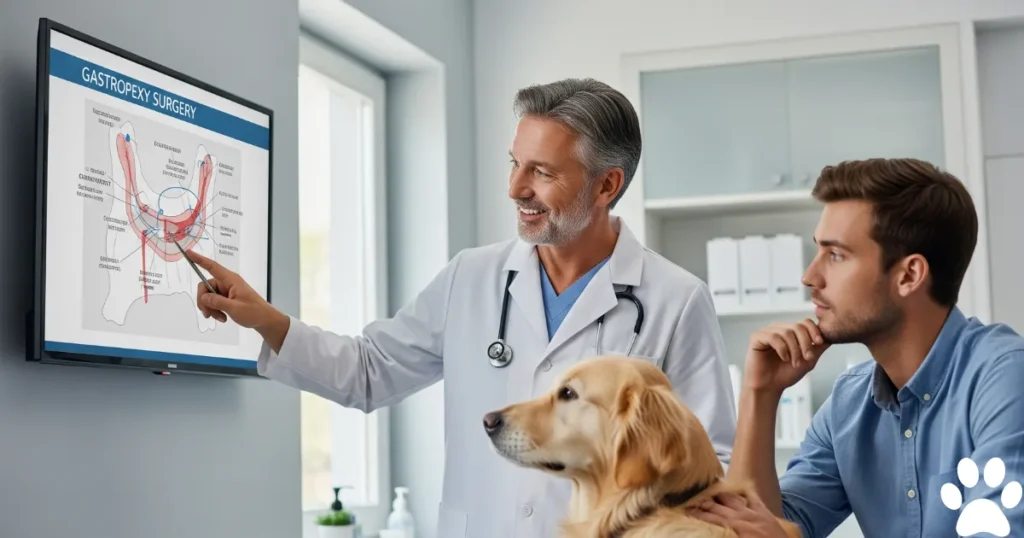
What to Do in an Emergency with Gastric Diversion? – Immediate Actions for Owners
When it comes to GDV in dogs, every second counts. Taking quick action can be vital for your Golden Retriever. It is important to know the proper steps to take in an emergency, especially if you notice symptoms such as a distended belly dog, restlessness, and uncontrollable vomiting.
First Aid at Home
If you suspect your Golden Retriever has a gastric diversion:
- Do not give him food or water, as this may increase gas or cause vomiting.
- Do not exercise your dog unless absolutely necessary. Exercise may cause further bloating.
- Contact your veterinarian or emergency room immediately.
- Describe the symptoms clearly: bloating, uncontrollable vomiting, restlessness, pale gums.
While you may want to wait and see, GDV in dogs progresses very quickly. Seeing your veterinarian within the first hour greatly increases your chances of survival.
What to Expect from Your Vet
On arrival at the clinic, the following will typically happen:
Immediate Diagnosis: X-rays and a physical exam are performed to confirm abdominal distension and assess its severity.
Stabilization: IV fluids, pain medications, and oxygen are administered in preparation for surgery.
Emergency Surgery: The gastric dilatation is repaired, and in most cases, a gastropexy is performed to prevent future attacks.
Recovery and Hospitalization: The hospital stay should last between 2 and 5 days, depending on complications and length of treatment.
In some cases, the distended abdomen dog symptoms may have other causes, such as abdominal distension or a feeling of fullness. However, bloat in dogs should always be considered an emergency until proven otherwise.
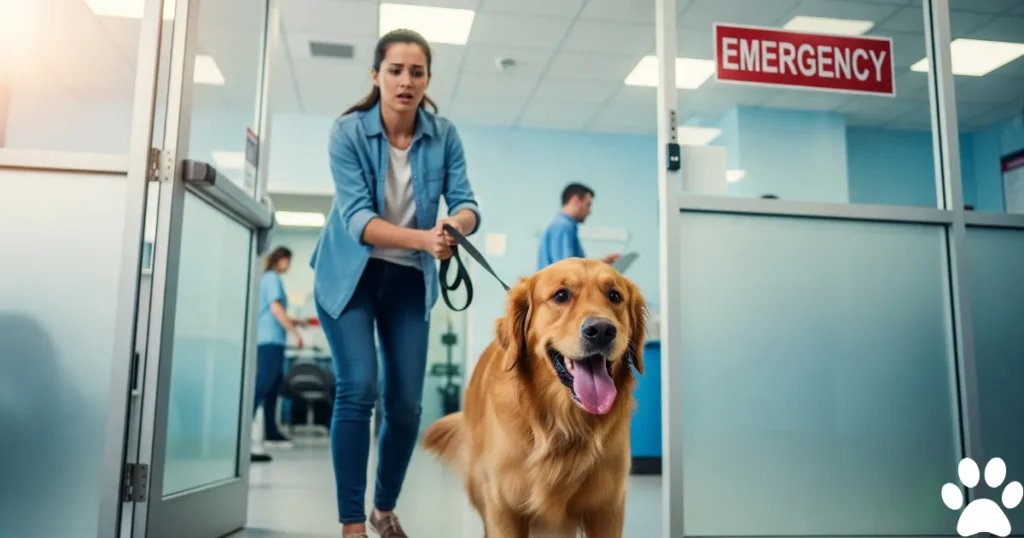
General Checklist – Protecting Your Golden Retriever from GDV
Preventing GDV in dogs starts with attention and consistent care. Golden Retrievers are especially susceptible, so preventative measures can be lifesaving. Here is a quick checklist to help you reduce the risk of a distended belly dog:
✅ Develop healthy eating habits
- Offer your dog smaller meals more frequently
- Use slow feeding bowls to prevent rapid eating
✅ Schedule exercise during meals
- Avoid exercise 1 hour before and after meals
✅ Watch for early signs
- Recognize the symptoms of a bloat in a Golden Retriever: bloating, non-productive vomiting, restlessness
✅ Have an emergency plan
- Have your vet’s phone number handy
- Find a 24-hour veterinary clinic near you
- Take immediate action at the first sign of a gastrointestinal infection
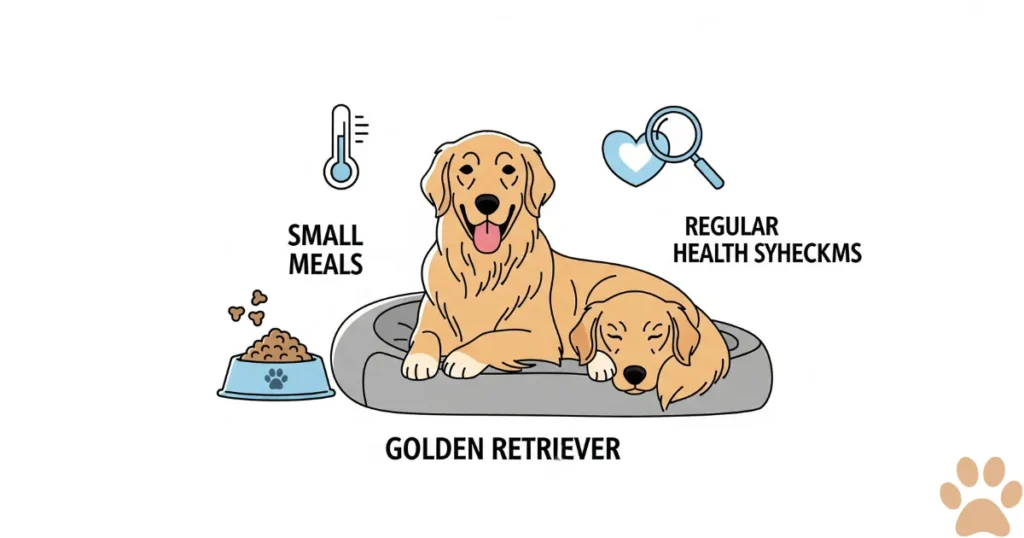
Final Thoughts – Act Before GDV Develops
GDV in dogs is not just a digestive problem; it is a rapidly developing, life-threatening condition. Breeds like the Golden Retriever are much more susceptible to a distended abdomen dog due to their body type and behavior.
Preventing bloat in Golden Retrievers requires reasonable daily care and regular veterinary monitoring. Simple measures such as splitting food portions, using slow-moving bowls, and controlling movement while eating can significantly reduce the risk.
Early detection and immediate action are critical. Never ignore signs such as bloating, non-productive vomiting, or sudden restlessness. These can quickly lead to fatal GDV.
Featured Blogs

13 Warning Signs of Bloat in Dogs Every Golden Retriever Owner Should Know
If you’re the proud owner of a Golden Retriever, recognizing signs of bloat in dogs means the difference between life...

Allergy Relief for Dogs Complete Guide for Golden Retriever Owners
Have you ever wondered, “Can dogs have allergies?” The answer is a resounding yes. Just like humans, dogs can experience...
Dr. Nabeel A.
Hi, I’m Dr. Nabeel Akram – a farm management professional by trade and a passionate Golden Retriever enthusiast at heart. With years of experience in animal science and livestock care, I’ve built a career around understanding animals—how they live, thrive, and bring value to our lives. This blog is a personal project born from that same passion, focusing on one of the most loyal and lovable breeds out there: the Golden Retriever. Whether I’m managing farm operations or sharing insights on canine health, behavior, and care, it all ties back to one core belief—animals deserve thoughtful, informed, and compassionate attention. Welcome to a space where professional expertise meets genuine love for dogs.
Facebook |

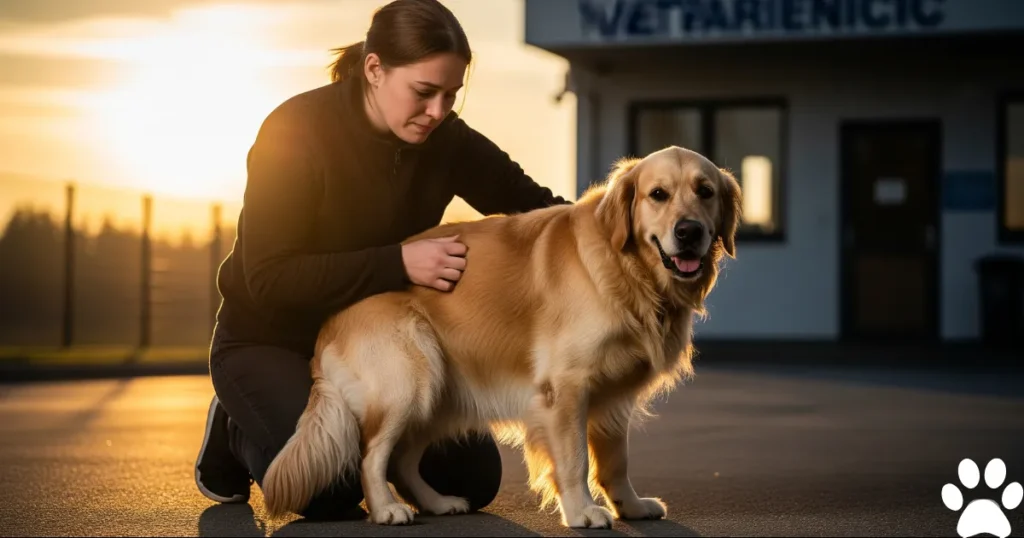
Links will be automatically removed from comments.